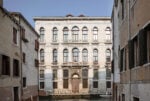Guido Guidi – Le Corbusier – 5 architetture
.jpg)
La serie di fotografie di Guido Guidi di alcune opere di Le Corbusier costituisce un progetto di lettura dell’opera del maestro nato all’interno di un progetto editoriale elaborato con l’editore Einaudi nell’ambito della collana ‘I millenni’, diretta da Mauro Bersani, che presenta le grandi opere letterarie. Il volume è stato pubblicato nel 2003 con il titolo Le Corbusier, Scritti, a cura di Rosa Tamborrino, Fotografie di Guido Guidi.
Comunicato stampa
La serie di fotografie di Guido Guidi di alcune opere di Le Corbusier costituisce un progetto di lettura dell’opera del maestro nato all’interno di un progetto editoriale elaborato con l’editore Einaudi nell’ambito della collana ‘I millenni’, diretta da Mauro Bersani, che presenta le grandi opere letterarie. Il volume è stato pubblicato nel 2003 con il titolo Le Corbusier, Scritti, a cura di Rosa Tamborrino, Fotografie di Guido Guidi.
Le fotografie di Guido Guidi sono parte integrante del progetto editoriale fin dall’inizio e contribuiscono al volume con un percorso di riflessione intorno a alcune opere scelte. In un contesto di creazione, nessun inserimento illustrativo sarebbe stato coerente, né alcuna fotografia di architettura immaginabile. Guido Guidi è l’artista che con una macchina fotografica dialoga con l’architetto-‘homme de lettre’, come Le Corbusier amava presentare se stesso: entrambi consapevoli del profondo valore interpretativo del vedere.
In un volume dedicato a uno scrittore che costruiva i suoi libri per collage di testi e di immagini, l’opera di Guido Guidi traccia un ritratto dell’architetto per frammenti. Visioni parziali, nient’altro che dettagli e, tuttavia, dettagli che si rivelano ermeneutici.
I soggetti sono stati scelti da Guidi in un possibile lungo elenco di edifici e incrociano in totale autonomia i temi proposti dal saggio introduttivo. Le esplorazioni a margine della grande opera, negli archivi come negli itinerari della fotografia, hanno portato verso ricerche su opere allora poco note. Le riprese di Guidi ne rivelano alcune (la fabbrica Duval) pressoché per la prima volta.
L’opera di Guidi nata da questo progetto però è ben più ampia di quella entrata a far parte del volume. La presente esposizione presenta, per la prima volta, un’ampia selezione del progetto di lettura di Guido Guidi di Le Corbusier. Rispetto alla selezione einaudiana, seppure generosa, nella mostra trae evidenza, non solo quantitativamente ma piuttosto nelle sue sfaccettature, un progetto ampio e alcune chiavi di lettura.
E’ l’Usine Duval, la fabbrica per la manifattura Duval a Saint–Dié des Vosges nell’immediato secondo dopoguerra (a partire dal 1946) a rivelarsi un cantiere straordinario per Guido Guidi almeno quanto per Le Corbusier.
L’insistenza con cui Guidi inquadra i particolari di un luogo, i materiali che si accostano nella costruzione, i colori che disegnano gli spazi, insieme alle annotazioni appiccicate ai muri, o ai contenitori dei tessuti della produzione, entra profondamente nel merito di un lavoro che Le Corbusier aveva concepito per una fabbrica diversa una ‘usine verte’, come aveva scritto ne La Ville radieuse.
Frammenti fotografici definiscono l’articolazione dei grandi volumi, delle geometrie pure, disegnate da contrasti di colore, dal gioco che pieni e vuoti, dal ‘pan de verre’, la prima parete tutta vetrata di Le Corbusier alla Cité de Refuge (completato nel 1933). L’inquadratura insistita invita a pensare segni e spazi - di cui risulta enfatizzata la percezione tridimensionale - fissando gli istanti repentini del loro apparire allo sguardo in riprese ‘lente’ che denotano, cioè, minimi slittamenti del punto di ripresa.
La serie di case si confronta con un tema architettonico radicalmente messo in discussione da Le Corbusier in favore di un’innovazione dell’idea di abitare.
Il lavoro di Guido Guidi, piuttosto che soffermarsi sui simboli di un vocabolario, scruta con apparente semplicità segni che si rivelano tracce di un pensiero. Di Le Corbusier emergono indizi di una ricerca incessante.
Testo di Rosa Tamborrino
La mostra proseguirà fino a Sabato 24 giugno 2017.
____________________________________________________
English version
Saturday May 6, 2017 - 11am
1/9unosunove is pleased to announce the opening of
Guido Guidi
Le Corbusier – 5 architetture
curated by Andrea Simi
The series of photos taken by Guido Guido of some of Le Corbusier's projects constitute a reading of the 'oeuvre' of the master conceived within an editorial project developed with publisher Einaudi as part of the series 'I millenni'. This series focuses on major literary works and is directed by Mauro Bersani. This volume was published in 2003 with the title: Le Corbusier, Scritti, by Rosa Tamborrino, Photos by Guido Guidi.
The photos by Guido Guidi are an integral part of the editorial project from the very beginning and contribute to the volume with a reflection on a selection of works. In the context of creation, no illustrative addition would have been coherent, nor any architectural image would have been conceivable. Guido Guidi is the artist who, with a camera, dialogues with the architect - 'homme de lettre', as Le Corbusier loved to present himself: both aware of the deep interpretative value of the act of observation.
In a volume dedicated to a writer who created his books with collage of texts and images, the work of Guido Guidi draws a portrait of the architect through fragments. Partial visions, nothing other than details that nonetheless, are details that turn out to be enlightening.
The subjects chosen by Guidi from a long list of buildings cross the themes proposed in the introductory essay in a completely autonomous way. The marginal investigations on the main oeuvre - in the archives as well as in the photos - led to research on lesser-known works. The shots of Guidi reveal some of them nearly for the first time, such as the Duval factory.
The work that Guidi created for this project is far more expansive than what has been included in the volume. With this exhibit, an extensive selection of the reading of Le Corbusier by Guido Guidi is presented for the first time. Compared to the admittedly generous selection in the volume by Einaudi, this exhibit shows - not just quantitatively but also in its facets - a wider project and more interpretations.
The Usine Duval, the factory for the Manufacture Duval in Saint–Dié des Vosges in the aftermath of World War II (started in 1946), was an extraordinary construction site for Guido Guidi as it was for Le Corbusier too.
Guidi's perseverance in framing the details of a place, the materials combined during the construction, the colors of the spaces, together with the notes glued on the walls or on the textile containers, deeply deals with a work that Le Corbusier had conceived for a different factory, a 'usine verte', as he wrote in the La Ville radieuse.
Photographic fragments define the articulation of the large volumes, of the pure geometries outlined by color contrasts, by the game of solids and voids, by the 'pan de verre', the first glass wall by Le Corbusier at the Cité de Refuge (completed in 1933). The dictated framing is an invitation to think of signs and spaces - of which the tridimensional perception is emphasized - seizing the sudden moments they appear through 'slow' shots that actually indicate minimal movements of the shooting point.
The series of houses confronts an architectonic theme radically questioned by Le Corbusier in favor of an innovation of the idea of living.
The work of Guido Guidi, rather than lingering on the symbols of a vocabulary, inspects with apparent simplicity the signs that reveal traces of a thought. What emerges are the clues of Le Corbusier's constant research.



